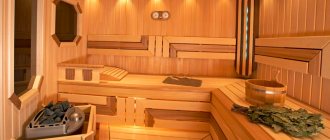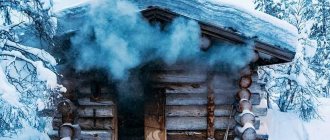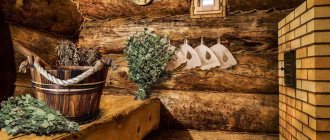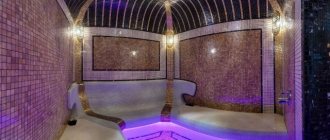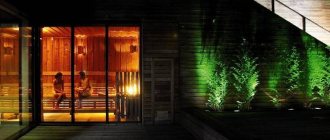Swedish bath bastu
(from Swedish “badstuga” - “baths”) is a unique combination of convenience and comfort. Its feature is the free circulation of air provided by a special ventilation system. Thanks to this, steamers can breathe easily and freely, even while in the sauna.
Considering the features of the Swedish bath, it is worth highlighting the constant movement of air masses. All rooms are regularly ventilated and dried. The structure of a Swedish bath is similar to an inverted glass.
Heating was carried out according to the following scheme:
- There were several cracks in the floor of the bathhouse opening onto the street.
- The air in the lower part of the steam room passed through the stove and was heated.
- Heated air masses rose upward, filled the steam room and pushed the cold through these cracks.
It is interesting that the principle of construction in the form of an “inverted glass” is still used today, but in a more modern design.
Features of a Swedish bath
The distinctive features of bastu are its mobility and small dimensions. It takes only a few hours to assemble this structure. It is easy to control, so it is often installed in private houses and even apartments (less often in verandas). In Sweden, such baths are very popular; they are installed in gyms, swimming pools, etc.
Interesting!
Bastu should not only be practical, but also have an attractive design.
That is why glass doors are often used for furnishing. Swedes value coziness and naturalness in their rooms, so a traditional basta cannot be imagined without a full set of bath accessories. These include lamps, thermometers, and tubs carved from wood for water.
The main advantages of saunas
Tylö's prefabricated saunas are a complete steam room complex, the assembly of which takes only a few hours.
Among the main advantages of Tylo ready-made saunas:
- elegant, modern design. The buyer is offered various finishing and filling options;
- compactness. The smallest models can be installed on only 1.3 square meters of area! Therefore, you can easily turn even a standard bathroom in a city apartment into a home SPA complex;
- Absolutely environmentally friendly. Natural wood is used for interior decoration - spruce, birch, alder, oak. All plastic components are vacuum formed under strict control. Tylö guarantees that both production technologies and finished products comply with all environmental requirements;
- comfortable and safe operation. Intuitive controls add to the enjoyment of using Tylo products;
- a wide range of models that can satisfy the needs of any buyer. There are both budget options and spacious premium spa complexes on sale. Regardless of the model you choose, using it will give you maximum pleasure and comfort.
Heating system bastu
The stoves in the Swedish bath are significantly different from the usual stone stoves. They are heaters (that's what the Swedes call them). To heat a room using an electric stove, 35-40 minutes is enough. For those who prefer steam baths, stoves with an air steam generator are installed.
Some stoves can be controlled electronically. Thanks to this, you can turn the oven on or off and set its operating time. When visiting a Swedish sauna, the stove does not stop working – it maintains a certain temperature inside the steam room.
Swedish sauna
Almost every state has its own national sauna. The Swedes call their steam room bastu, and that’s what this article will be about. In fact, the structure of the Swedish sauna is very similar to the Finnish one, you can even call these steam rooms sisters . The mobile structure is heated by electricity, so it is possible to install the basta directly in an apartment or house. This type of steam room can also be found in our Sauna Club catalogue.
It only takes a few hours to assemble a Swedish sauna in your home. The most important thing is to do everything according to technology and use the right types of wood. A stove for heating a room is also of great importance.
The Swedish sauna is made from the best types of wood. Most often, well-treated timber is used for construction. You can use spruce or Canadian hemlock for this purpose. And the interior decoration is made from coniferous trees. As a rule, this is cedar or well-treated pine. Cedar is a rather expensive material, but at the same time the most reliable and beautiful. Aspen or abah (African tree) can also be used. These tree species are best chosen for making benches, flooring and other sauna interior elements. The wood used to make a steam room always undergoes a special moisture-repellent treatment, which significantly increases its service life and endurance.
For insulation, a layer of mineral wool is laid; the Swedes adopted this trick from their neighbors, the Finns . But unlike the Finnish sauna, Bastu does not use a foil gasket. The Finns specially lay shiny paper for insulation. The Swedes believe that it only dries out the wood and does not give the desired result.
Electric furnaces in Bastu are the same as in a Finnish sauna. They turn on with one press of a button and can maintain the required temperature for a week. One stove can heat up a Swedish sauna in just half an hour. Only the Swedes themselves call their electric furnaces “heaters.”
The Swedish sauna has one distinctive feature. During construction, a round porthole window is cut into the wall . If this is not possible, the window can be mounted directly into the door. The exact purpose of this addition is not known, but the porthole adds some zest to the interior of the building. Especially if there is a beautiful view outside the window.
Comparison of traditional bastu with modern baths
Comparing the ancient bathhouse with modern buildings, several differences can be identified. So, instead of natural ventilation (slots), special openings are installed - one is located under the stove, the other is on the opposite side.
During construction, lining made of natural cedar or spruce wood is used for external wall cladding. These rocks have a pleasant fragrance when the temperature rises, moreover, they do not emit resin. To provide thermal insulation, foil or mineral fiber is used.
My bathhouse
Bastu (buffet bath) became famous many centuries ago. The peoples who inhabited modern Sweden have been melting and steaming in it since the dawn of time.
What is special about this bath? In design, it looks like a Finnish sauna - a log house made of wood with a place for a firebox (hearth). But the bastu has flowing ventilation, the air in it does not stagnate, so it is much easier to breathe in this steam room.
Scandinavian steam rooms - sauna and bastu - are universally famous. However, in the heyday of church tyranny (the Middle Ages), steam rooms had a bad reputation. They were considered a breeding ground for infections and promiscuity. But the troubled times passed, and even the church recognized the usefulness and convenience of the Swedish bath - they are installed in the Vatican.
Natural wood is used to build the bastu. Preferred species are spruce and cedar. The nobility of cedar cannot be compared with anything. The cedar steam room has an orange-golden hue. Cedar practically does not emit resin. This property is highly valued. Its healing effect on the respiratory tract, heart and nervous system allows it to remain a leader among tree species used for steam rooms. The disadvantage is the high price of this tree. In rare cases, alder or aspen is used for a log house. But they will not replace the smell of pine needles. Only spruce and cedar basta have the aroma of the forest, the thick and rich smell of resins. They help you relax better when vaping, have phytoncidal properties, and return a person to the bosom of nature and naturalness.
What did a traditional Swedish bath look like? The design of the bath should allow air flow through the steam compartment. Therefore, the floor of the bathhouse had cracks, and the bathhouse rose above the surface of the ground. Heated light air filled the steam room, and cold air escaped through the cracks in the floor. This principle is called "inverted glass". In modern steam rooms it has been modernized, but its basics have been preserved. A constant air flow ensures good drying of the wood and prevents the formation of mold. The bastu contained a tub for dipping and a bed. Sometimes the steam room was located above the water, then, upon leaving the steam room, you could immediately plunge into the cool water of the Swedish lakes.
What does a modern bastu look like? Now a steam room can be installed even in an ordinary multi-storey building. The main thing is to ensure ventilation and access to utility systems. And of course no hearth. The steam room is heated by an electric oven. Often everything is automated. Push-button control. On the one hand, this makes kindling easier. Doesn't require much time to heat up. The Swedish bath becomes accessible and easy to use. On the other hand, the bathhouse flavor is lost. But this is a tribute that must be paid to progress.
Bastu is an excellent option for a steam room. Both the traditional old Swedish version and modern collapsible cabins have their own amatures. This is a bathhouse that has been tested for centuries.
.
What are the advantages of bastu?
In ancient times, palaces and castles in the Vatican and Monaco were equipped with Swedish baths. Today they not only have not lost their merits, but have also significantly expanded their list.
So, the advantages of a Swedish bath include:
- Possibility of arranging a small-sized bath complex in your own home;
- Automated bastu control - just use the remote control to select the heating mode and temperature;
- Swedish baths have been proven to be the safest in the world.
The benefits of regularly visiting bastu are obvious - strengthening the immune system, improving overall health, getting a boost of energy and good mood.
Interestingly, the Swedes do not usually use brooms or washcloths for steaming. They use special brushes with which you can achieve complete and deep cleansing of the skin. Today, bastu is settled not only in Sweden, it has become widespread all over the world, incl. in Russia.
But if a Russian bathhouse is important to you, then you can order the construction of a bathhouse from timber from our company. We build quickly and efficiently!
House made of laminated timber 110 m² with sauna
- Finland
- 110 m²
- Kuusamo Hirsitalot
- 1
- wood
The small one-story house is made of laminated veneer lumber. It seems light and airy thanks to the huge area of glazing, which rises almost to the very top of the building. For some interior walls, frame technology was chosen. The timber frame was filled with soundproofing slabs and covered with two layers of plasterboard. GKL made it possible to create an ideal, smooth surface for painting.
The bright living room, the height of which runs right up to the very tip of the roof, is combined with the dining room and kitchen. On one of the walls the glazing stretches along the entire length of the building. However, it is not continuous, since in a wooden house such a technique can disrupt the connections between structural elements, which is fraught with unpleasant consequences.
The house has three bedrooms (parent's, children's and guest), a bathroom, a laundry room and, of course, a sauna - an indispensable attribute of Finnish life
Read more in the article “Bold Mix”
4
Log cottage with sauna 90 m² made of dead pine
- Finland
- 90 m²
- 1
- log house
The northern kelo pine is often called a silver tree - its noble gray shade is unlikely to leave anyone indifferent. But besides its outlandish beauty, kelo also has a lot of other advantages. Dried on the root, it is particularly dense, has low shrinkage and is invulnerable to fungi and mold. That's why it's loved in Finland.
The country house Villa Maria, located 40 kilometers from Helsinki on the shore of a picturesque lake, was built from kello pine. The one-story building has a rectangular plan, its area is 90 m². From the outside the house looks like a fairytale hut, but inside it has a modern, laconic interior.
The layout is extremely simple: the living room, dining room and kitchen are combined, there are two bedrooms, a separate bathroom and, of course, a sauna - an integral part of almost every Finnish home
Country house 75 m² consisting of two buildings with a compact sauna
- Finland
- 75 m²
- Aleksi Hautamaki Milla Selkimaki, photo Marc Goodwin
- 1
- frame
The couple had been looking for a place to build their own holiday home for five long years until they found this coastal island on the edge of the Kemiensaari National Park. Here they decided to build their dream house - or, more precisely, even two cottages.
The project is called Ö Cabin, where “Ö” means “island”. The complex consists of a main house, which contains living quarters and a sauna, and a separate compact cottage with a workshop. Both buildings are designed in such a way as to be as functional and comfortable as possible despite their small dimensions. The unique location of the site became the main inspiration for the architects and the opportunity to apply interesting solutions in the construction of houses.
Read more in the article “It’s him, it’s him!”
5
Cheap house 30 m² with steam room, built by two students on a wetland
- Finland
- 30 m²
- studio politaire
- 1
- frame
Architecture students Timm Bergmann and Jonas Becker decided to test themselves and design a house. They built the house together, only occasionally resorting to the help of friends.
For construction, the novice architects chose an undeveloped forest site in Finland. Before starting work, they carefully studied the territory, the nuances of the landscape, conducted a soil analysis and developed a project based on the results obtained.
The frame of the house was installed on a foundation of galvanized water pipes that a local contractor welded together. Mostly natural materials were used for construction. So, the box was assembled from locally produced lumber and multi-layer plywood.
The interior space consists of four zones that flow into each other: the kitchen leads to a small living room, behind which there is a bedroom and a sauna. There were no communications on the site; currently the house is not even connected to electricity. The heat is provided by a metal wood-burning stove, as well as a stove in the sauna. A dry toilet was installed in the yard.
Read more in the article “Oh, how many wonderful discoveries we have…”
6



